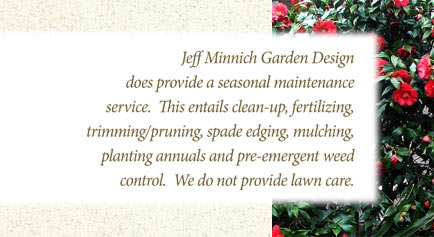|
|
|
|

...prune now as severely as you’d like. These bloom off the new growth produced this spring. Things like Clematis, Hydrangeas, Roses—these particular plants can vary on their pruning rules even by variety or type, so best to look up online or give me a call before you cut and sacrifice the bloom. Often, the reason plants don’t bloom is because they were pruned at the wrong time. Non-blooming plants, deciduous or evergreen—you have a lot more leeway here and you can prune almost anytime. But remember, with all pruning (like anything else) there are exceptions to the general rules. When in doubt, check before you cut.
- Staking/tying up—after yet another damaging winter, there is much to be staked and/or tied up. In some cases, it’s best to prune; in others, staking and tying are fine. I love the black, plastic, chain lock strap available at any garden center. It is strong and easy to use. It’s my tying-up tool-of-choice. It’s best done with two people—one to hold the branches in place and the other to tie. You can either tie the branches together within the shrub or stake it and tie it to pull it back into place. Many people have asked me if the branches/stems/trunks will regain their former strength…my answer is that some will and some won’t; it depends on the plant. Sorry to be so vague!
- Fertilizing—the big feed on lawns is usually in the fall since that’s when it’s most beneficial. If you want to feed in the spring, a weed and feed product is good to hold back the broadleaf weeds. Also, don’t forget to put down pre-emergent crabgrass control ASAP—blooming forsythia is your signal to get busy on the crabgrass control. Shrubs, groundcovers, landscape plants—I usually only fertilize when I think a plant could use a boost…if a plant looks vigorous and healthy, I don’t bother. If I do fertilize, I like Woodace, Plant Tone, and Holly Tone. Old-fashioned 5-10-5 and 10-10-10 work well, too. These last two work well in the annual and perennial beds, too. You could also use well-rotted compost or manure for your vegetable and annual beds. For pots, I use Osmocote. It’s time-released and lasts the season. On all these, follow the instructions on the sack so you don’t burn the plants. If your plants’ leaves are yellow with the green veins showing, they probably need iron…very common in plants like Azaleas, Gardenias, and other acid-loving plants. Use Ironite or a chelated iron product you can spray on.
- Edging and mulching—Re-edge your beds with a spade so they are nice and crisp, then mulch with no more than 2-3 inches of hardwood, pine bark or pine straw (needles). Hardwood mulch binds together best, so it won’t wash as much in hilly areas. The bigger the chip on the pine bark, the more it floats and the harder it is to plant annuals through it (you’ll find the trowel stabs the chips!!) Make sure you don’t have the mulch up against tree trunks and stems of plants…plants need to breathe and there is a lot of oxygen/carbon dioxide exchange going on where the trunk/stem meets the soil. If you have many layers of old mulch already in place, you may want to rake some of that out, or just very lightly top dress. Studies have shown that a too-deep mulch layer turns into a “false soil” layer; the roots of a plant will grow easily in this layer and not go deeply into the soil. This is not good because that thick mulch layer does not have the nutrients of the soil below. This can result in deficiencies…a common one is the iron deficiency I mentioned above.
- Weed prevention—we like to use a product called Preen on the beds after we mulch. It’s not a cure-all, but it sure does go a long way in helping to prevent weed growth. It’s a pre-emergent, so it zaps the weed seeds as they are beginning to emerge. And it will zap any seeds coming up, so not a good idea to use it in areas you are seeding, like vegetable and annual beds. Know this about the herbicide Round-up, too: it is non-selective, so if you spray to control weeds, it will kill EVERYTHING in its path. It’s a great product and works through the plant, not the soil, to kill it. Thus, it becomes inactive when it hits the soil, so you can immediately plant in an area sprayed with Round-up. But be careful what you hit when spraying. You don’t want to lose a prized plant.
- Planting times—it’s perfectly fine to plant all trees and shrubs now. We’ve started. We find it best to put perennials in after the ground has warmed a bit and the perennials have had a chance to get some growth on them. So we generally wait until late...
Spring Chores continued >
|



